
Historical
and Cultural Context
Historical and Cultural
Context | Site
Map | On-Line
Resources | Rules
of Thumb | Glossary |
Quotes | WordList
| Co-Teachers - Doug
and Melissa | Gallery
E-Mail Doug at mrdoug@aznet.net
or Melissa at mjmckinstry@earthlink.net
The High Middle Ages (1000-1300) -
"The Age of Faith" in Europe
1000-1150 - As a product of improved farming techniques -
the iron plow pulled by horses replacing its wooden cousin pulled by
oxen and the three-field system replacing the two-field system,
scholars estimate that the population of western Europe rose by 40
percent, from around 30 million to about 42 million (WH, p. 224).
1000-1009 - Olaf I Tryggvesson of Norway, who with the
assistance of English monks Christianized Norway, Iceland, and
Greenland, dies fighting the forces of the Danish and Swedish Kings.
With his death, the Danes conquer and rule Norway.
The Viking King, Sweyn Forkbeard, attacks the English and exacts
tribute from them in retaliation for Ethelred II's massacre of Danish
settlers the previous year.
The Fatimid caliph of Egypt, al-Hakim, destroys the Church of the
Holy Sepulchre in Jerusalem, encouraging Europeans to recover the
Holy Land. However, Europeans don't mobilize until 1095 (http://www.historychannel.com).
1010-1019 - The year 1012 marks the first recorded
persecution of heresy in the German states.
The Danes conquer England, compelling the Anglo-Saxon monarch,
Ethelred II, to seek refuge in Normandy.
The Norwegian King, Olaf II, establishes his state's independence
from Norway and begins to re-Christianize his Kingdom (http://www.historychannel.com).
Top
1020-1029 - Europe suffers an epidemic of St. Vitus' dance
(Sydenham's chorea), a neurological form of rheumatic fever that can
cause involuntary movement.
Boleslav the Brave proclaims himself King of Poland, declaring his
country independent of the Holy Roman Empire. Although he dies within
a few months, Boleslav leaves behind a powerful country that acquired
considerable territory.
Guido d'Arezzo, a Benedictine monk, introduces solmization, the
practice of sol-faing (singing doh, ray, mi, fah, sol, lah, te), to
music (http://www.historychannel.com).
1030-1039 - The Arab physician Avicenna (Abu Sina) writes
his Canon of Medicine, which is based on the ideas of
Aristotle and Galen and influences medical thinking for centuries to
come.
Guido d'Arezzo pioneers musical notation and invents the great
scale (gamut), the hexachord, and hexachord solmization (http://www.historychannel.com).
1040-1049 - Scottish ruler Duncan Canmore is slain by his
nobles, who invite Macbeth, King of Inverness, to succeed Duncan.
Macbeth accepts and rules until 1057 (http://www.historychannel.com).
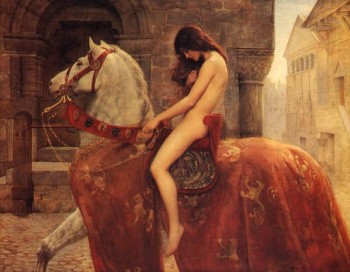
John Collier's - Lady Godiva - c. 1898 -
http://www.artmagick.com/paintings/painting1630.asp
A naked (and longhaired) Lady Godiva rides through the streets of
Coventry in an attempt to persuade her husband, Leofric, earl of
Mercia, to stop levying heavy taxes on the population (http://www.historychannel.com).
Pi Sheng, a Chinese printer, begins using movable type of hundreds
of clay blocks containing Chinese ideograms for printing (http://www.historychannel.com).
Top
1050-1059 - The Eastern (Orthodox) and Western (Roman)
churches enter into a schism when mutual anathemas are exchanged at
Constantinople between Cardinal Humbert of Lorraine, representing the
papacy, and Patriarch Michael Cerularius. The schism is never
healed.
Malcolm Canmore murders Macbeth, who is succeeded by his stepson
Lulach (http://www.historychannel.com).
1059 - A Church decree declared that all future popes would
be chosen at a meeting of leading bishops known as cardinals. No
longer could the Roman mob, the local nobles, or even the emperor
choose a pope (WH, p. 228).
1060-1069 - The University of Parma holds its first
classes. Universities arose in the Middle Ages to train young men in
law, theology, and medicine. Although they were usually established
by royal or ecclesiastical initiative, some were founded by students.
The medieval university often had thousands of students and played an
important role in contemporary affairs.
After 13 years of building, Westminister Abbey is consecrated in
1065.

Halley's tail from Mt. Wilson
http://www.seds.org/nineplanets/nineplanets/pxmisc.html#Comets
The comet that will ultimately be named after English astronomer
Edmund Halley appears in the sky.
The Normans introduce the French words boeuf, mouton, veau, porc,
and poularde into the emerging English language. In England, the
words will eventually evolve into beef, mutton, veal, pork, and
poultry (http://www.historychannel.com).
Top
1070-1079 - Hildebrand is elected to succeed Pope Alexander
II and takes as his name Gregory VII. During his reign, Gregory will
attack simony, enforce celibacy among the clergy, and champion the
power of the papacy.
The Synod of Rome promulgates strict decrees against simony (the
purchase or sale of church offices). Many German bishops oppose
Gregory's elevation to the papacy.
Gregory VII compiles the Dictatus Papae, a collection of
canons supporting the power of the papacy.
In response to the issue of lay investiture, which draws the
papacy and European rulers into conflict, German Emperor Henry IV
calls the Synod of Worms in 1076, which declares Pope Gregory VII
deposed. In response, Gregory deposes and excommunicates Henry.
German Emperor Henry IV makes his penance at Canossa, and Gregory
VII reluctantly absolves him in 1077. Yet the German nobles elect an
anti-King to rival Henry with the approval of Gregory's legates
(http://www.historychannel.com).
1080-1089 - In Salerno, Italy, a medical school that draws
on the knowledge from Greek, Latin, Jewish, and Arabic texts begins
to thrive.
The Synod of Rome declares Pope Gregory VII deposed and recognizes
the anti-pope, Clement III. Due to the Normans' sack of the city,
supporters take Gregory to Salerno.
The Oath of Salisbury makes vassals responsible directly to the
English King.
In England, King William the Conqueror orders that a Domesday
Book, a list of assets of landowning people, be compiled for purposes
of taxation and administration.
The idea of the magnetic compass is born when Chinese waterworks
director, Shen Kua, notes that direction can be found by rubbing a
needle on a lodestone and hanging it by a thread; the needle
usually-though not always-points south (http://www.historychannel.com).
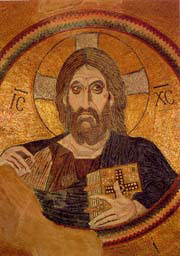
Pantocrator - Mosaic, c. 1080-1100, Church of
the Dormition, Daphne, Greece -
This mosaic portrays the bust of a stern and menacing Christ. With
his furrowed brow and drawn expression, he is no longer the
benevolent Shepherd of comfort from Early Christian iconography.
Pantocrator, shows Christ as the "Ruler of the Universe." Backed with
gold and surrounded by small windows, this mosaic appears
illuminated, transcending that boundary between heaven and earth,
giving human emotion to a powerful symbol, and revealing a little
more of the artist's own expression (http://www.artcellarexchange.com/millarc1.html)
1090-1099 - Pope Urban II calls for a crusade to take back
the Holy Land from the Muslims who now occupy it. Urban's invitation
receives an enthusiastic response. Religious motives dominated the
Crusades at first, but worldly aims were never absent: The nobles
hoped to capture land and loot; the Italian cities looked to expand
trade with the Middle East (http://www.historychannel.com).
1096 - Oxford, the oldest English-speaking university in
the world, lays claim to eight centuries of continuous existence.
There is no clear date of foundation, but teaching existed at Oxford
in some form in 1096 and developed rapidly from 1167, when Henry II
banned English students from attending the University of Paris.
Top
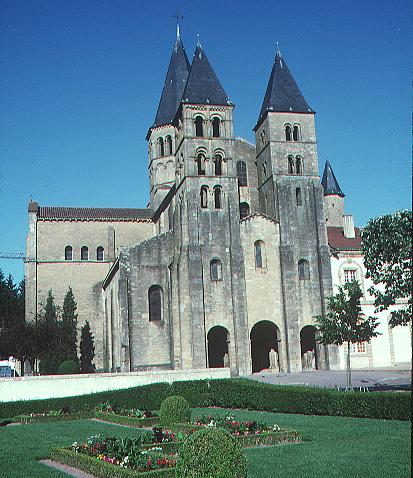
Basilica, Paray-le-Monial, France - 1090-1110
-
Example of Romanesque architecture prevalent between 1000 and
1100
http://www.bc.edu/bc_org/avp/cas/fnart/arch/romanesque_arch.html
1100's - Few Europeans lived beyond the age of 50 (WH, p.
223).
1110-1119 - The earliest positive record of the performance
of miracle plays comes from Dunstable, England. Miracle play or
mystery play, form of medieval drama, developed (10th-16th cent.) by
the addition of dialogue and dramatic action to the Roman Catholic
liturgy. Originally performed in Latin, miracle plays were later
given in the vernacular. Based on the Scriptures and on the lives of
the saints, they were given in churchyards and marketplaces on church
festival days and lasted from sunrise to sunset (http://www.historychannel.com).
1120 - Anglo-Saxon scientist Welcher of Malvern pioneers
the measurement of the earth in degrees, minutes, and seconds of
latitude and longitude (http://www.historychannel.com).
1122 - At the Concordat of Worms, Holy Roman Emperor Henry
V renounces his right to invest bishops with the symbols of their
office, the ring and staff; allows the clergy to be elected freely;
and promises to restore church property (http://www.historychannel.com).
1120-1129 - Cistercian monks from Normandy travel to
England and reclaim land, improve agriculture, and breed animals. As
a result, they fine-tune horse and cattle breeds and raise standards
of agriculture (http://www.historychannel.com).
Top
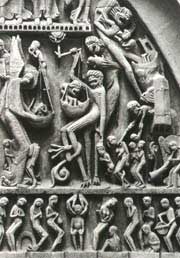
The Last Judgment Relief, west tympanum, Autun
Cathedral, Burgundy, France - c.1130-35 -
http://www.artcellarexchange.com/millarc1.html
1136 - Abbot Suger completes the abbey church of
Saint-Denis in northern Paris. The church's pointed arches and rose
and clerestory windows are the architectural stamps of the Gothic
style (http://www.historychannel.com).
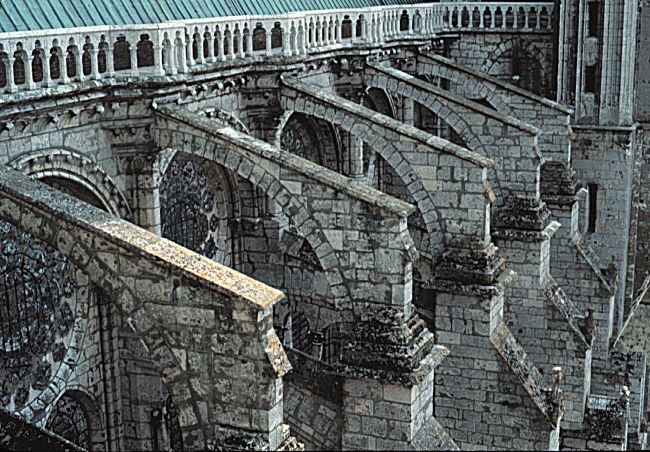
Notre Dame, Chartres, France, flying buttresses - 1145-1220
-
http://www.bc.edu/bc_org/avp/cas/fnart/arch/chartres.html
1140 - Judah ben Samuel ha-Levi (Abu'l Hasan), a Spanish
rabbi, dies. His most important philosophical work, the Sefer
ha-Kusari, argues that revealed religion is superior to rational
belief (http://www.historychannel.com).
1145-1220 - After two generations of back-breaking labor,
the townspeople of Chartres celebrated the dedication of their new
cathedral (WH, p. 223).
Top
1150-1159 - Chinese seamen and caravan leaders employ crude
magnetic compasses to navigate their journeys.
The foundation of the University of Paris is laid.
The music of the troubadours becomes popular in southern
France.
Iceland issues the first fire and plague insurance (http://www.historychannel.com).
1162 - Theobald, archbishop of Canterbury, dies. King Henry
II supports as successor his chancellor, Thomas Becket, thinking that
Thomas will easily bend to the King's will. Henry was wrong
(http://www.historychannel.com).
1163 - Thomas Becket's defense of clerical privilege
against the crown puts him at odds with Henry II shortly after the
King returns to England from the Continent in 1163.
The Spanish physician Maimonides (Moshe ben Maimon) leaves Cordoba
and travels to Fez and then to Cairo, where he becomes the personal
physician to Saladin, sultan of Egypt. During his career, Maimonides
writes on medicine, law, math, logic, and theology (http://www.historychannel.com).
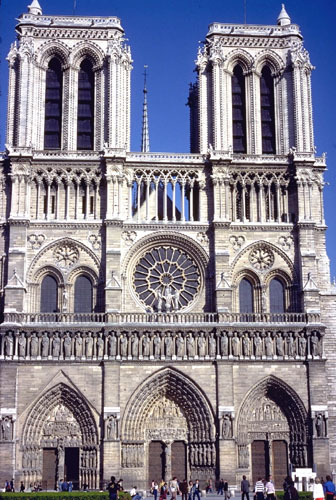
Medieval Cathedral of Notre-Dame, West Facade
- Paris, France - 1163-1250 -
http://www.pitt.edu/~medart/menufrance/pndmain.html
Top
1170 - Thomas Becket returns to England after six years of
exile in France. Although the King and archbishop have officially
reconciled, tensions soon mount, and Henry II's men murder Thomas in
Canterbury Cathedral on December 29.



Leaning Tower of Pisa -
http://www.cibernet.it/thebox/pisa/tower.html
Official site - http://torre.duomo.pisa.it/index_eng.html
1174 - Architect Bonnano Pisano builds a 177-foot bell
tower (campanile) that will eventually come to be known as the
Leaning Tower of Pisa (http://www.historychannel.com).
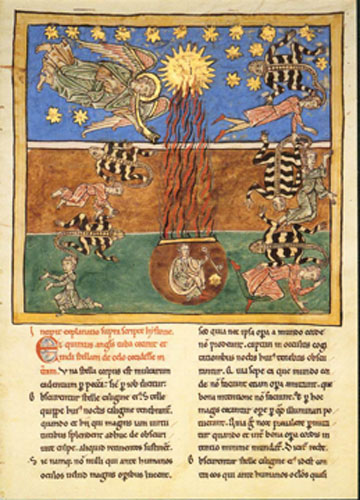
Locusts Come upon the Earth - c. 1180 -
http://www.kfki.hu/~arthp/html/zgothic/miniatur/1151-200/index.html
1182 - Jews are banished from France (http://www.historychannel.com).
1189 - The Third Crusade begins with the Holy Roman
Emperor, Frederick Barbarossa, in the lead (http://www.historychannel.com).
Top
1200 - Venice is the commercial capital of Europe. The city
is blessed with a strategic geographic location that enables
Venetians to easily trade in the East, the Mediterranean basin, and
central Europe (http://www.historychannel.com).
Compared to great cities like Constantinople or Baghdad, European
towns were still primitive and tiny. Europe's largest city, Paris,
probably had no more than 30,000 people by the year 1200. A typical
town in medieval Europe had only about 1,500 to 2,500 people (WH, p.
224).
1200 - According to canon law, bishops were to use at lest
one fourth of all tithes to care for the sick and the poor. Orphans,
lepers, and beggars received are from Church funds. Most hospitals in
medieval Europe were operated by the Church. Around the year 1200,
there were 400 hospitals in England and 12 in Paris alone. No needy
person could be turned away (WH, p. 230).
1202 - Europe begin to learn about Arabic numerals and the
zero from the Liber Abaci, written by the Italian Leonardo
Fibonacci.
Jesters begin to appear in European courts (http://www.historychannel.com).
1208 - Students from Bologna found the famous medical
school at Montpellier (http://www.historychannel.com).
1215 - King John I of England is forced to sign at
Runnymede the Magna Carta, a charter that limits the power and
privilege of the English monarchy in favor of the English barons
(http://www.historychannel.com).
1217 - Cambridge University is founded (http://www.historychannel.com).
1222 - Mongol leader Genghis Khan invades Russia, making
his first appearance in Europe (http://www.historychannel.com).
1225 - Cotton begins to be manufactured in Spain and
becomes a competitor of wool and linen (http://www.historychannel.com).
Popes started its war against heresy. The Inquisition was an
organization of experts whose job was to find the judge heretics.
These men left no stone unturned in their search for heresy, even
accepting rumors and gossip. A person who was suspected of heresy
might be questioned for weeks and even tortured. It was almost
impossible for a suspect to prove his or her innocence (WH, p.
230).
Top
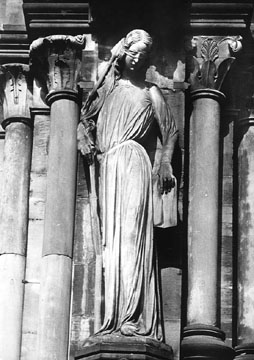
Synagoga (Synagogue), column figure, South
Transept Portal, Strasbourg Cathedral - c. 1230 -
http://www.kfki.hu/~arthp/html/zgothic/gothic/1/index.html
Church and Synagogue were common allegorical figures in the Middle
Ages. Draped females, they are ways of representing the transition
from the Old Law to the New. Synagogue is always a blindfolded
figure, the blindfold representing moral or spiritual blindness or
darkness, sin, and ignorance. Often a crown falls from the inclined
head of Synagogue and the Tables of the Law fall from her hands.
1231 - Holy Roman Emperor Frederick II founds a medical
school in Salerno, Italy. The curriculum includes three years of
logic, five years of medicine, and one year of practice. The school's
director is Nicolaus Praepositus, author of the first medieval
pharmacopoeia
Surgeons at the medical school in Salerno, Italy, begin to dissect
human bodies, signaling a gradual change in European attitudes toward
corpses (http://www.historychannel.com).
1235 - Frederick II commissions Michael Scot to translate
into Latin the works of the ancient Greek philosopher Aristotle
(http://www.historychannel.com).
1236 - Theodoric of Lucca, a Dominican friar, pioneers the
use of anesthesia when he advocates applying to the nose of patients
undergoing surgery sponges soaked in narcotics. He also supports the
use of the opiates mandrake and opium in similar situations
(http://www.historychannel.com).
Top
1247 - St. Mary of Bethlehem Hospital for the insane opens
in England. Suggesting what the conditions of the hospital were like,
the modern word bedlam is derived from its name (http://www.historychannel.com).
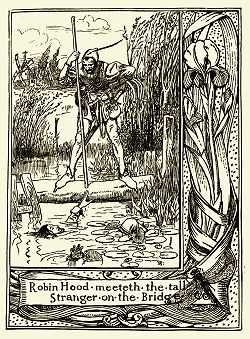
Robin Hood - http://www.legends.dm.net/robinhood/
In York, England, a tombstone identifies Robert, earl of
Huntington, as Robin Hood. Robert died in December (http://www.historychannel.com).
Roger Bacon, a Franciscan friar, advocates making science part of
the curriculum at Oxford University, maintaining that science
complements, not opposes, religion (http://www.historychannel.com).
1250 - Notre Dame Cathedral was completed in Paris (HM, p.
500).
Crusaders introduce the decimal system into Europe.
Crusaders introduce spices such as cinnamon, cloves, coriander,
cumin, cubebs, ginger, mace, and nutmeg to Europe. Often they are
valued more for their medicinal value than for their flavor
(http://www.historychannel.com).
Top
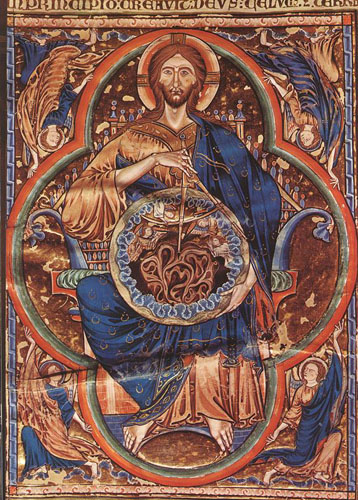
Bible - Illuminated Gothic Manuscript -
1252-70 -
http://www.kfki.hu/~arthp/html/zgothic/miniatur/1251-300/index.html
1253 - Robert de Sorbon, chaplain and confessor of Louis IX
of France, opens the Community of Poor Masters and Scholars, later to
be known as the Sorbonne, the first college of the University of
Paris (http://www.historychannel.com).
1259 - While repelling a Mongol invasion with bullets shot
through bamboo tubes, China's Sung armies pioneer the use of firearms
that propel bullets (http://www.historychannel.com).
1269 - Roger Bacon, a scientist at Oxford University, draws
plans for the magnetic needle and reading glasses (http://www.historychannel.com).
1271 - Marco Polo-along with his father, Niccolo, and uncle
Matteo- begin a journey to India and the Far East (http://www.historychannel.com).
1275 - Moses de Leon's Zohar, the fundamental work
on Jewish mysticism, is finished. Cabala [Heb.,=traditional
lore], mystical Jewish system of interpretation of the
Scriptures. Cabala is based on the belief that every word, letter,
number, and even accent of the Scriptures contains mysteries.
Cabalistic signs and writings are used as amulets and in magical
practices (http://www.historychannel.com).
1280 - Marco Polo travels to Hangchow, which Polo says
surpasses in greatness all the other cities in the world. Polo is
particularly struck by the pleasures available, such as spices and
silks (http://www.historychannel.com).
1291 - Venetians develop the great galley, which
facilitates trade by enduring long voyages and accommodating large
cargoes (http://www.historychannel.com).
1295 - Marco Polo returns to Venice, bringing with him,
among other things, spices and eastern cooking customs (http://www.historychannel.com).
1298 - Textile production is revolutionized with the
invention of the spinning wheel (http://www.historychannel.com).
Historical and Cultural
Context | Site
Map | On-Line
Resources | Rules
of Thumb | Glossary
| Quotes
| WordList
| Co-Teachers - Doug
and Melissa
| Gallery
| Top
E-Mail Doug at mrdoug@aznet.net
or Melissa at mjmckinstry@earthlink.net
|

|
Melissa and I would like to
thank znet
for
making a commitment to
education and WriteDesign.
|













